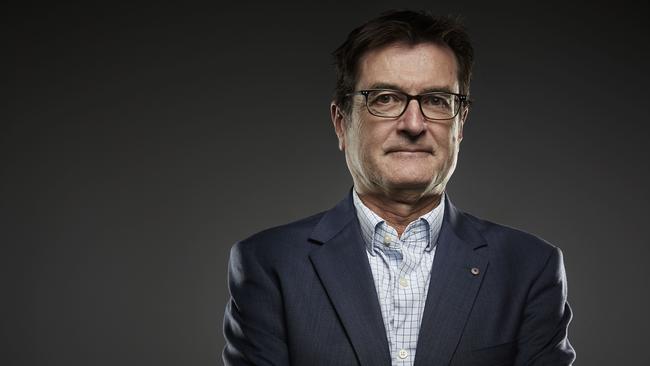Super giant to impose 100pc carbon reduction targets
Emissions reductions targets of up to 100 per cent will be slapped on assets including Ausgrid.

Australia’s biggest energy network will face an unprecedented emissions reduction target as its owner — industry superannuation giant IFM Investors — launches an ambitious project to cut carbon across its vast asset holdings.
Emissions reductions targets of up to 100 per cent by 2030 will be slapped on a broad range of infrastructure assets across the nation, including the Ausgrid electricity network, Melbourne and Brisbane airports, and NSW ports.
The move risks stoking a conflict with the Morrison government, which has sought to clamp down on social and environmental activism by industry super funds.
The $140 billion IFM Investors, chaired by former ACTU head Greg Combet and co-owned by 27 of the biggest industry super funds, including AustralianSuper, Hostplus and Cbus, also controls or has large stakes in assets such as the Port of Brisbane, Southern Cross Station in Melbourne and Northern Territory Airports.
IFM Investors will announce today a move to strip 200,000 tonnes of carbon dioxide annually from the assets by 2030 — equal to removing almost 70,000 cars from the road.
According to its Paris Agreement target, Australia will reduce emissions to 26-28 per cent on 2005 levels by 2030.
Following the collapse of the Coalition’s national energy guarantee last year, IFM Investors will apply an emissions reduction target of between 8 and 25 per cent on infrastructure projects by 2024, and of 38 to 100 per cent by 2030.
Ausgrid, which was half-privatised by the NSW Liberal government for $16bn in 2016, is the largest energy network in the country, supplying more than 1.6 million homes and businesses across Sydney, the NSW central coast and the Hunter region.
It will now attempt to reduce its emissions by 8 per cent over the next five years, and by 17 per cent by 2030. To achieve this, IFM will invest in a range of solar energy projects, launch efficiency upgrades on its buildings, install thousands of energy-efficient lights and use low-emission vehicles. NT Airports, meanwhile, is hoping to achieve a 100 per cent emissions reduction by 2030.
The emissions reduction program comes after the government’s $10bn Clean Energy Finance Corporation, established by the Gillard government in 2012, invested $150 million last year into IFM to help lower emissions across the country’s largest infrastructure assets.
IFM head of Australian infrastructure Michael Hanna said it made “perfect business sense” to cut emissions by “reducing costs, mitigating future business risks and contributing to outcomes that our customers value”.
“This exciting initiative represents a genuine commitment and start to aligning our assets to the Paris Agreement,” Mr Hanna said.
Clean Energy Finance Corporation boss Ian Learmonth said the reductions had “the potential to make a material impact” on Australia’s carbon footprint. “This … sets an important example for other major infrastructure owners and managers,” he said.
Deep divisions between union-backed funds and big business surfaced this year when Josh Frydenberg asked the prudential regulator whether it had the power to ensure union-appointed super trustees did not pursue political objectives at the expense of members’ interests.
The Treasurer’s intervention came after the ACTU backed a Maritime Union of Australia campaign for industry funds to pressure BHP and BlueScope Steel into reversing a decision to forgo the renewal of a legacy contract for two Australian-crewed vessels — the last servicing the iron-ore industry.
AustralianSuper, the nation’s largest fund — where ACTU president Michele O’Neil is an alternate board director — also joined a throng of major institutional investors to pressure global commodity group Glencore to cap its coal production.
Industry funds have an equal-representation board model, meaning they appoint directors from unions and employer groups. Together, they have $677bn of assets under management — more financial power than the bank-run retail fund sector ($623bn), or public sector funds ($475bn).
Last week, the US Business Roundtable overturned 57 years of corporate orthodoxy holding that the only purpose of a corporation was to generate profit for shareholders by publishing a new “statement on the purpose of a corporation”. The statement sought to elevate the concerns of customers, employees and communities. It was signed by 181 chief executives, including Lachlan Murdoch, the chairman and chief executive of Fox Corporation and co-chairman of News Corp, ultimate publisher of The Australian.
Ausgrid, which owns the NSW energy distribution network, triggers the majority of its emissions through electrical line losses by transmitting power over long distances. While these particular costs would be too “prohibitive” to clamp down on, IFM said it would tackle inefficient street lights, which account for 11 per cent of emissions, and convert more than 250,000 to energy-efficient bulbs.
The company will also install more than 11,500 rooftop solar panels across its work sites. Excluding the emissions for line losses, the program will cut Ausgrid’s emissions by 44 per cent by the end of 2024.
IFM and AustralianSuper jointly own 50.4 per cent of Ausgrid for a 99-year lease.
IFM owns 25 per cent of Australia Pacific Airports Corporation, which owns Melbourne Airport under a 50-year lease.
It also owns 20 per cent of Brisbane Airport Corporation, which controls the airport under a 49-year lease. IFM owns 45 per cent of NSW Ports, which manages Port Botany and Port Kembla, the Enfield Intermodal Logistics Centre and Cooks River Intermodal Terminal.



To join the conversation, please log in. Don't have an account? Register
Join the conversation, you are commenting as Logout